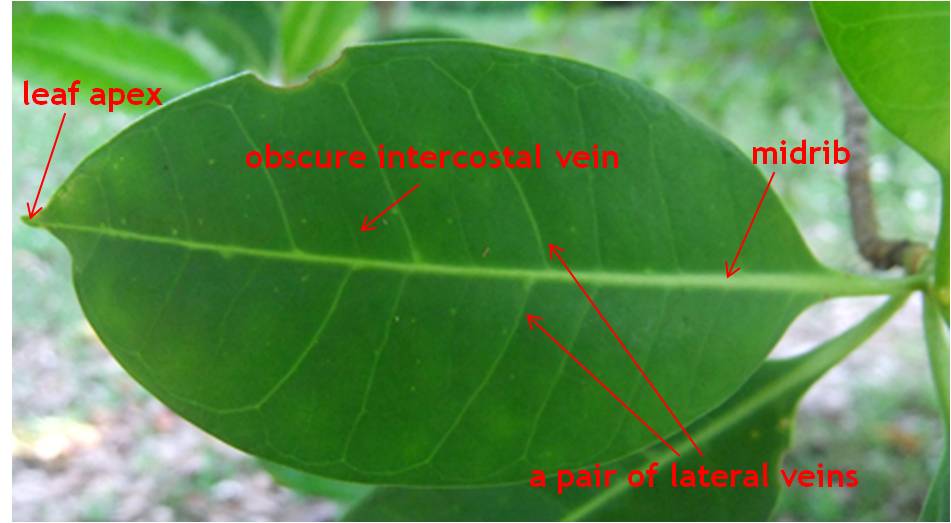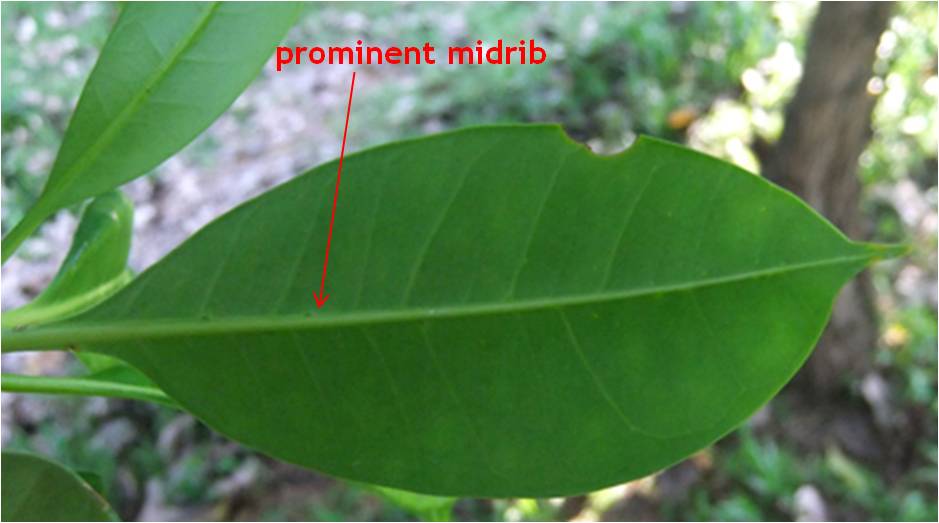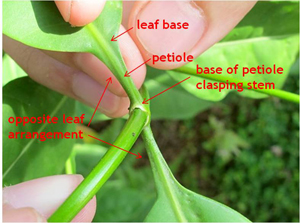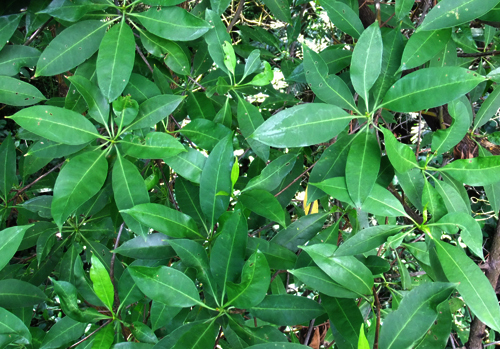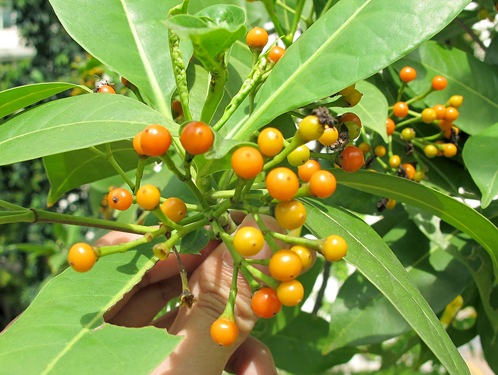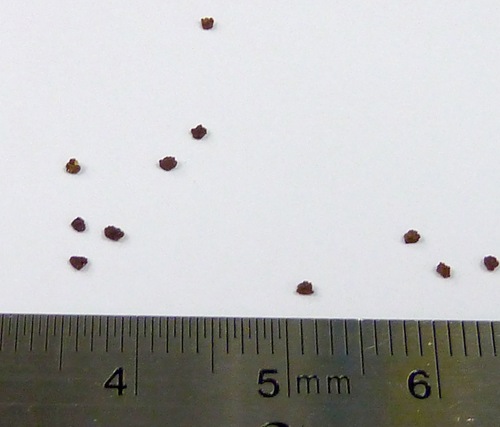| "If it were asked what trees were distinctive of Singapore, we would point to the Tembusu-trees of Tanglin for specimens as fine cannot be found on any part of the mainland. For this advantage we are indebted to the constitution of the tree which is accustomed to poorly aerated and ill-drained situations so that its roots find little fault with the heavy, yellow clay of the island."Corner, E.J.H. Wayside Trees of Malaya2, p.468 |
Table of Contents
|
||
NOMENCLATUREEtymologyFagraea = after J.T. Fagraeus (1729-1747), a Swedish naturalist.fragrans = (latin) after the fragrance of the open flowers2.Fagraea fragrans is an accepted name3,4. |
||
Recent synonymsWillughbeia fragrans Spreng.; Fagraea ridleyi Gand. [Illegitimate]; Fagraea peregrina (Reinw.) Blume; Cyrtophyllum peregrinum Reinw.; Cyrtophyllum lanceolatum DC.; Cyrtophyllum giganteum Ridl.; Cyrtophyllum fragrans (Roxb.) DC.3 |
DESCRIPTIONHabit1,2,8,10 Fagraea fragrans grows as a tree, sometimes as a shrub. The species can grow to a maximum height of 35m. The tree appears to branch rather low down along the trunk. The branches grow perpendicular to the trunk for a short distance, then shoot vertically upwards, giving one the impression of an upturned palm with multiple fingers reaching for the heavens. The crown can be conical in young trees, and is more irregular in older trees. The trees can grow up to 2.5m in diameter, and sometimes have buttresses of up to 2.5m. |
|
|
|||||
| Bark8,10 The bark of the trunk is very distinctive with its deep ridges and irregular fissures. The colour of the bark may be dark brown, grayish or black. |
|
| Leaves1,2,8,10 The leaves of Fagraea fragrans are simple, elliptical, entire, and sub-coriaceous.The midrib is prominent on the lower side of the leaf. There are 9-12 pairs of lateral veins, which are distinct, flat to slightly prominent on the lower side of the leaf, and flat and indistinct to obscure on the upper side of the leaves. The intercostal veins are obscure. The leaf apex is cuspidate. The leaves are 4-14 x 1.5-6cm in dimension. |
||||||
|
|
|||||
| The leaf base is acute and decurrent on the petiole. The petioles are 0.5-2.5cm in length, and enlarge at the base into a ring that clasps the stem. Fagraea fragrans leaves are oppositely arranged. |
|
|
||||
|
Inflorescences1,2,8,10,13 The flowers of Fagraea fragrans grow in a many-flowered cluster known as a cyme (a type of inflorescence). The cymeis axillary, 6.5-12cm long and 4-7cm wide, with the main axis branching 2-3 orders. The cyme can be quite dense. The peduncle is 4-6cm long. The individual flowers are whitish-yellow and fragrant. They turn yellow when old. Each individual flower is bisexual and has 5 petals. In each flower:
(See pollination.) |
| Fruits1,2,5,8,10,18 The fruits are smooth and round with a small pointed tip. They are two-celled and 0.75-1cm in diameter. Each fruit weighs 1.2g on average. They ripen from green to yellow to orange to red. According to Corner2, the fruits are bitter. (See dispersal.) |
|
|
||||
|
||||||
| Seeds5,8,10,18 There are 20-30 seeds in each fruit. They are less than 1mm in diameter, and are angular and scarbrous. The seeds are brown and have a very thin seed coat. Sterile seeds are around 4 times smaller than fertile seeds. |
|
|||||
return to top
BIOLOGY
Growth and Phenology
The growth of Fagraea fragrans is rather slow2,10. Corner encapsulated the "lethargic" growth of the species in the following description2:"...the Tembusu responds very slowly to the climatic stimulus, its flowers opening after an interval of nearly four months. But in all its activities the tree is leisurely. It grows slowly: it develops new leaves a pair at a time, never in flush like so many of our eager trees: its flower-buds need several weeks to open: its flowers last for several days and are not morning-glories or night-dreams like so many others: and the tiny berries require more than three months to mature. Such sluggishness is remarkable in a tropical plant, the environment of which imposes no hindrance upon its growth, but it is not unparalleled for both Mangosteen and Nutmeg are almost, if not quite, as lethargic."Corner, E.J.H., Wayside Trees of Malaya p.468
According to Corner, the regular seasonality in the flowering and fruiting of Fagraea fragrans gives reliable indication of the slight seasonality of the tropics2. There are two flowering seasons: in May to early June, and in October to November2. Holttum observed that flowering takes place “about four months after the onset of dry weather”17; the flowering event in May follows the period of dry weather in mid January, and the flowering event in October follows the dry spell in June to July2.Holttum also observed that the period between the fertilization of the flowers to the ripening of the fruit is usually around seven and a half months17.
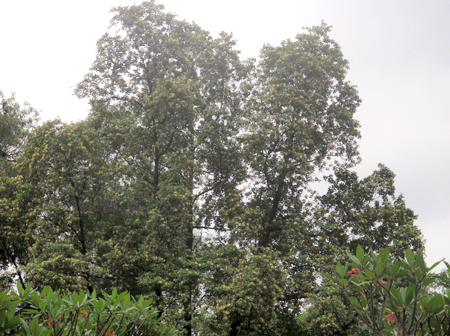 |
| Fagraea fragrans trees in bloom. Photo by Louise Neo. |
Ecology
Pollination The flowers of Fagraea fragrans open in the evening2. The fragrance of the flowers is particularly strong thus in the evenings and at night, and this is when pollination is usually carried out, by butterflies and by moths (e.g. of the genus Macroglossa)1,2,10.
Dispersal The fruits are dispersed by bats (Pteropus edulis and Cynopterus spp. according to Ridley) and some birds, especially starlings1,10. They may also be eaten by fruit-eating ants (Polyrachis sp. according to Ridley)1.
Corner2 described his observations of how flying foxes (bats of the genus Pteropus) used to feed on the fruits of Fagraea fragrans trees in the past:
"This yearly event, the fruiting of Tembusu trees, which takes place in September and sometimes again in January if there has been a second flowering during the preceding year, is one of the marvels and mysteries of local natural history. The flying foxes arrive from far and wide, flapping across the evening sky from the islands to the south, from the mangrove swamps on the mainland, and even, from the coast of Sumatra, but how they know the season of the Tembusu trees, whether they have scouts or by what sequence they are led to return, for at other times they are scarcely to be seen, we do not know. For two or three weeks they revel nightly in the succession of berries, squawking and fighting for position on the trees, disgorging the skins and seeds in red splashes."
Natural Habitat
Fagraea fragrans grows naturally in lowland (sea level to around 800 m) secondary or disturbed forest, coastal or beach forest, and even lalang fields1,8. In Borneo, it is found in Kerangas (Sundaland heath forest)8. In Singapore, it is found to be associated with species such as Adinandra dumosa and Dillenia suffruticosa in the “Adinandra belukar” type of “anthropogenic heath forest”12. It may be a pioneer species of areas that have been burned-over1.
Fagraea fragrans is tolerant of humid, seasonally swampy conditions. It grows on poorly aerated or swampy or compact soils, and also on poor sands or podsols1.
return to top
DISTRIBUTION
Native range
Asia-Temperate1,8,11Japan
Asia-Tropical1,8,11 India: Bengal (near Calcutta), the Andaman islandsIndo-China: Vietnam, Cambodia13, Laos, Myanmar,ThailandMalesia: Peninsular Malaysia, Sabah and Sarawak (west coast), Borneo (all territories), Sumatra, Java (naturalized), Bawean, Sulawesi, Philippines (Balabac, Palawan, Busuanga, Culion, Mindoro), Japen island near Northwest New Guinea, the Moluccas.
Also cultivated.
Status in Singapore
Fagraea fragrans is native to Singapore, found commonly, and also cultivated9.return to top
USES
Symbolic
Owing to the magnificence of the trees of this species, Fagraea fragrans has been used as an icon in various ways. A Fagraea fragrans tree is illustrated on the back of the Singapore $5 note (first issued in 1999). This individual can be found growing on Lawn E in the Singapore Botanic Gardens, and has been declared a Heritage Tree. This tree is believed to have been growing in the same spot even before the Singapore Botanic Gardens was established in 185919.
 |
| The illustration of a Fagraea fragrans tree on the back of the Singapore $5 note. Image by Louise Neo. |
The vernacular name tembusu has also been used considerably in Singapore, suggesting its cultural significance. A local University college and an equity firm have been named after the species.
Ornamental
Fagraea fragrans is commonly planted as a shade tree along streets, and in parks and gardens all around Singapore1,10. Many trees of this species used to be planted in the Tanglin area of Singapore2,19. Fagraea fragrans is also planted for ornamental purposes elsewhere in Southeast Asia1,13.
|
|
|
Forestry
The timber of Fagraea fragrans is yellow, fine to medium-textured, hard, and very durable1,10,14. The trade name is tembesu15. It has various uses including agricultural implements, general boat-building and furniture14. One of its notable uses in Singapore is in making chopping boards 10. The timber is no longer available commercially10, but it is still used directly in some parts of Oceania and Southeast Asia14.
In Cambodia, the wood of Fagraea fragrans is considered to be very valuable and in such high demand that the species has become over-exploited, and the number of mature trees has declined significantly13.
Medicinal
Parts of Fagraea fragrans have been used in traditional medicine. The bark has been used in decoction as a febrifuge, for example to cure malaria. In Kedah, Malaya, a decoction of the leaves and twigs has been drunk for dysentery1.
return to top
SCIENTIFIC CLASSIFICATION
| Linnaean Hierachy6 |
Angiosperm Phylogeny Group III System7 |
| Kingdom: Plantae |
Kingdom: Plantae |
| Phylum: Magnoliophyta |
Clade: angiosperms |
| Class: Magnoliopsida |
Clade: eudicots |
| Clade: core eudicots |
|
| Clade: asterids |
|
| Clade: euasterids I |
|
| Order: Gentianales |
Order: Gentianales |
| Family: Gentianaceae |
Family: Gentianaceae |
| Genus: Fagraea |
Genus: Fagraea |
| Species: fragrans |
Species: fragrans |
Fagraea fragrans was placed previously in the family Loganiaceae1,2,4,8. However, recent work16 has shown Loganiaceae to be a heterogeneous assemblage of families, and has separated them out more distinctly, putting the genus Fagraea in the family Gentianaceae3,8,9. Plants from Gentianaceae can be distinguished from those from Loganiaceae by being hairless on the inside of the corollas (instead of having hairs), and by their petal lobes that contort in bud (instead of being valvate (not overlapping) or imbricate (overlapping))20.
return to top
TAXONOMY
Diagnosis
A species diagnosis is important in helping one tell different members of the same plant family and genus apart.FamilyDiagnostic features of the family Gentianaceae include20:
Genus Three sections have been recognised in the genus Fagraea8:Fagraea, Cyrtophyllum and Racemosae
Fagraea fragrans belongs to the section Cyrtophyllum.
| Section |
Fagraea |
Cyrtophyllum |
Racemosae |
| Axillary scales |
Develop above the petiole base and loosely clasp the stem |
Develop at the very base of the petiole and tightly clasp the stem |
Similar to Cyrtophyllum |
| Inflorescences |
Either a solitary flower or cyme-like with the primary branches rebranching 1-3 times |
Cyme-like with primary branches that rebranch 3-6 times; stamens and styles conspicuously exsert |
All branches very condensed and grouped in distinct tiers along the main axis; stamens and styles are not or only slightly exsert in the open flower |
| Fruits |
Typically large at maturity, always more than 25 mm across, with the epidermis detaching from the pericarp on drying |
Less than 20 mm across with the epidermis not detaching from the pericarp on drying |
Similar to Cyrtophyllum |
| Seeds |
Ellipsoid-rounded |
Angular |
Similar to Cyrtophyllum |
Species
This dichotomous key is an aid for separating out morphologically similar species from the genus Fagraea.
1. Fruits typically large at maturity (always more than 25mm across), the epidermis detaching from the pericarp on drying. Inflorescence either without any branching (with only a solitary flower) or with well-developed primary branches (which resemble the lower internodes of the main axis in length) that rebranch typically only once but exceptionally (in F. floribunda) to 3 orders. Axillary scales developing above the petiole base and loosely clasping the node..................................................................................................................................................2Key to species adapted from Tree Flora of Sabah and Sarawak8. Note: the key has been truncated to include only the sections relevant to Fagraea fragrans.
Fruits always smaller (less than 20mm across), the epidermis not detaching from the pericarp on drying (sometimes the pericarp wrinkled). Inflorescence either pendulous or with all branches very condensed and grouped as distinct tiers along the main axis, or with well-developed primary branches that rebranch 3-6 orders. Axillary scales developing at the very base of the leaf stalk and slightly clasping the node.................................................................................2828. Inflorescence pendulous or typically with all branches very condensed and grouped in distinct tiers along the main axis. Stigma capitate but at maturity developing an expanded rim that gives it a peltate structure. Stamens and style not or only slightly exsert in the open flower.........................................................................................29
Inflorescence rigid and erect, with well-developed primary branches (as long as the lower internodes of the main axis) that rebranch 3-6 orders. Stigma capitate throughout, an expanded rim not developing. Stamens and style long-exsert in the open flower...............................................................................................................................................3535. Inflorescences exclusively axillary.........................................................................................36
Inflorescences terminal.........................................................................................3836. Inflorescence a 3-branched cyme, or (sometimes) reduced unbranched inflorescence, (1-)3-flowered. Corolla tube 10-12 mm long. Leaves coriaceous, the margins never wavy, with lateral veins 3-6 pairs...........................................................................................................................F. caudata
Inflorescence a many-branched, many-flowered cyme. Corolla tube 6-8mm long. Leaves chartaceous with wavy margins, or leaves (sub)coriaceous with lateral veins 9-12 pairs....................................................................................................................3737. Inflorescence peduncle 4-6 cm long. Open flowers with calyx diameter 2-2.5 mm, corolla lobes (5-)6-7 mm long and 3-4 mm wide, and styles exsert for 8-10 mm. Leaves with 9-12 pairs of lateral veins which are flat on the upper surface, and plane margins when fresh...........................................................................................................................F. fragrans
Original description and holotype
A holotype is the very first physical example of the species that was referenced by the person who first described the species. It thus "typifies" the species. As there can only be one single example of the species that was first referenced and described, there can only be one holotype.The original description of a species is the very first description that was written about the species, and is the description to which the given species name is attached.Fagraea fragrans was originally described by Dr. William Roxburgh in the 1800s in Flora Indica. Carey & Wallich ed.s vol. ii. p. 32 , based on a specimen found by Dr. William Hunter in “Pullo Penang” (type locality) (probably modern day Penang Island, Peninsular Malaysia)5. The holotypehas been attributed in the Tree Flora of Sabah and Sarawak8 to “Hunter, s.n. (=Wallich, Cat. no. 1597E)”, and thus probably resides presently in the “Wallich Collection” of the Kew Herbarium (Kew Royal Botanic Gardens in London).
return to top
LITERATURE AND REFERENCES
return to top
OTHER PAGES ON THIS SPECIES
return to topCOMMENTS
Please feel free to leave any comments that you have on this species in the following comment box.

